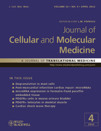KATP channel agonists preserve connexin43 protein in infarcted rats by a protein kinase C-dependent pathway
Abstract
Downward remodelling of gap junctional proteins between myocytes may trigger ventricular arrhythmia after myocardial infarction. We have demonstrated that ATP-sensitive potassium (KATP) channel agonists attenuated post-infarction arrhythmias. However, the involved mechanisms remain unclear. The purpose of this study was to determine whether KATP channel agonists can attenuate arrhythmias through preserving protein kinase C (PKC)-ε–dependent connexin43 level after myocardial infarction. Male Wistar rats after ligating coronary artery were randomized to either vehicle, nicorandil, pinacidil, glibenclamide or a combination of nicorandil and glibenclamide or pinacidil and glibenclamide for 4 weeks. To elucidate the role of PKCε in the modulation of connexin43 level, carbachol and myristoylated PKCε V1–2 peptide were also assessed. Myocardial connexin43 level was significantly decreased in vehicle-treated infarcted rats compared with sham. Attenuated connexin43 level was blunted after administering KATP channel agonists, assessed by immunofluorescent analysis, Western blotting, and real-time quantitative reverse transcription-PCR of connexin43. Arrhythmic scores during programmed stimulation in the KATP channel agonists-treated rats were significantly lower than those treated with vehicle. The beneficial effects of KATP channel agonists were blocked by either glibenclamide or 5-hydroxydecanoate. Addition of the PKC activator, phorbol 12-myristate 13-acetate and the specific PKCε agonist, carbachol, blocked the effects of nicorandil on connexin43 phosphorylation and dye permeability. The specific PKCε antagonist, myristoylated PKCε V1–2 peptide, did not have additional beneficial effects on connexin43 phosphorylation compared with rats treated with nicorandil alone. Chronic use of KATP channel agonists after infarction, resulting in enhanced connexin43 level through a PKCε-dependent pathway, may attenuate the arrhythmogenic response to programmed electrical stimulation.




